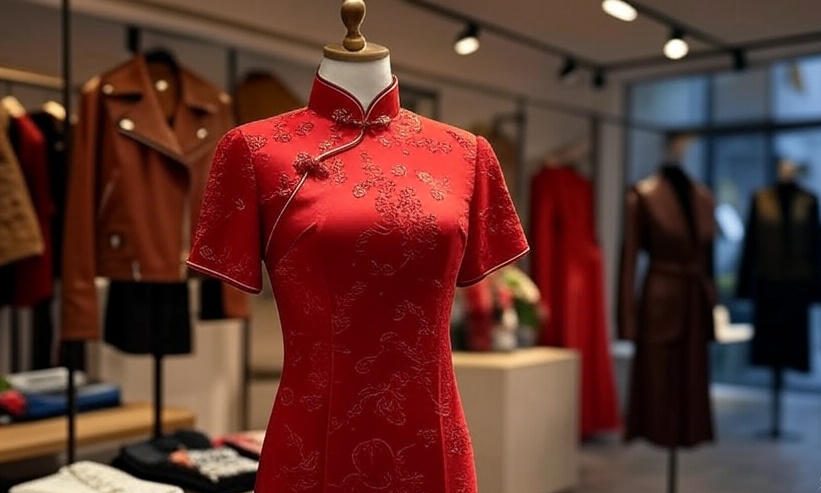
Traditional Chinese garments like qipaos and hanfus carry centuries of history in their intricate designs. These clothes, once confined to cultural festivals or historical dramas, now grace European streets, signaling a shift in global cultural dynamics. This rise reflects China’s growing influence through cultural diplomacy, where fashion becomes a quiet yet powerful tool to shape perceptions abroad. Amid evolving East-West relations, traditional Chinese fashion serves as both a cultural ambassador and a subtle geopolitical statement.
Platforms like RobesChinoises Fashion Clothing (Vêtements De Mode) in France showcase this trend, offering Europeans access to authentic qipaos and other traditional garments. These websites do more than sell clothes; they bridge cultures, inviting curiosity about China’s heritage. By wearing a qipao at a Paris gala or a hanfu at a London cultural event, individuals embody a piece of China’s story. This act of wearing transcends personal style, becoming a statement of cultural appreciation and, at times, a political gesture in a world where global narratives often clash.
Why does clothing hold such sway? Fashion has always been more than fabric. It’s a language of identity, history, and values. A qipao, with its elegant silhouette and embroidered patterns, tells a story of China’s past—its artistry, its resilience, its traditions. When Europeans embrace these garments, they engage with that narrative. This exchange fosters understanding, but it also carries weight in geopolitical contexts. As tensions rise over trade or technology, cultural exports like fashion soften China’s image, projecting a legacy of beauty and sophistication.
Fashion as Cultural Diplomacy
Cultural diplomacy thrives on subtle influence. Unlike hard power, which relies on economic or military might, soft power persuades through appeal. China has long used cultural exports—think pandas, calligraphy, or martial arts—to build goodwill. Fashion, however, offers a uniquely personal connection. When someone wears a hanfu, they don’t just admire Chinese culture; they inhabit it. This act creates empathy, sparking conversations about heritage over politics. Consequently, traditional Chinese fashion becomes a tool to humanize a nation often viewed through the lens of global competition.
Europe’s embrace of these garments also reflects a broader trend: the hunger for authenticity. Fast fashion dominates, but many seek unique, meaningful pieces. A qipao, with its hand-stitched details, stands out in a sea of mass-produced clothing. This demand fuels platforms like RobesChinoises.fr, which cater to those craving cultural depth. Yet, this trend isn’t without complexity. Some critics argue that wearing traditional garments risks cultural appropriation. Others see it as appreciation, a way to honor and learn from another culture. The debate underscores the power of fashion to spark dialogue.
Geopolitical Threads in Every Stitch
Fashion’s role in geopolitics isn’t new. Think of the kimono’s global allure or the sari’s cultural resonance. For China, traditional clothing carries added weight amid strained East-West relations. As trade disputes or human rights debates dominate headlines, cultural exports like fashion offer a counter-narrative. They remind the world of China’s contributions to art and beauty. A qipao worn at a diplomatic event in Brussels, for instance, subtly shifts focus from political friction to shared humanity. Similarly, exploring political footwear trends reveals how even shoes can signal political intent, underscoring fashion’s role in shaping global perceptions.
Moreover, fashion aligns with China’s broader soft power strategy. The Belt and Road Initiative, while economic, also promotes cultural exchange. Fashion fits neatly into this framework, traveling across borders without the baggage of political rhetoric. When a European influencer dons a hanfu, they introduce their audience to Chinese aesthetics. This ripple effect amplifies China’s cultural presence, one garment at a time. Yet, it’s not one-sided. Europeans wearing these clothes often reinterpret them, blending them with Western styles, creating a fusion that reflects globalization’s complexity.
A Global Wardrobe
What does this mean for the future? Traditional Chinese fashion’s rise in Europe signals a world where cultural boundaries blur. It’s not just about aesthetics; it’s about connection. A qipao at a Milan fashion week or a hanfu at a Berlin art exhibit shows how fashion transcends borders. But it also raises questions. Can clothing truly bridge divides in a polarized world? Or does it risk becoming a superficial gesture? The answers depend on how we engage with these cultural symbols.
For now, traditional Chinese fashion continues to weave its way into Europe’s cultural fabric. Each garment tells a story—of history, artistry, and diplomacy. As more people embrace these clothes, they participate in a quiet but profound exchange, one that shapes perceptions and challenges stereotypes. Fashion, in its elegant simplicity, proves that even a single dress can carry the weight of a nation’s aspirations.
